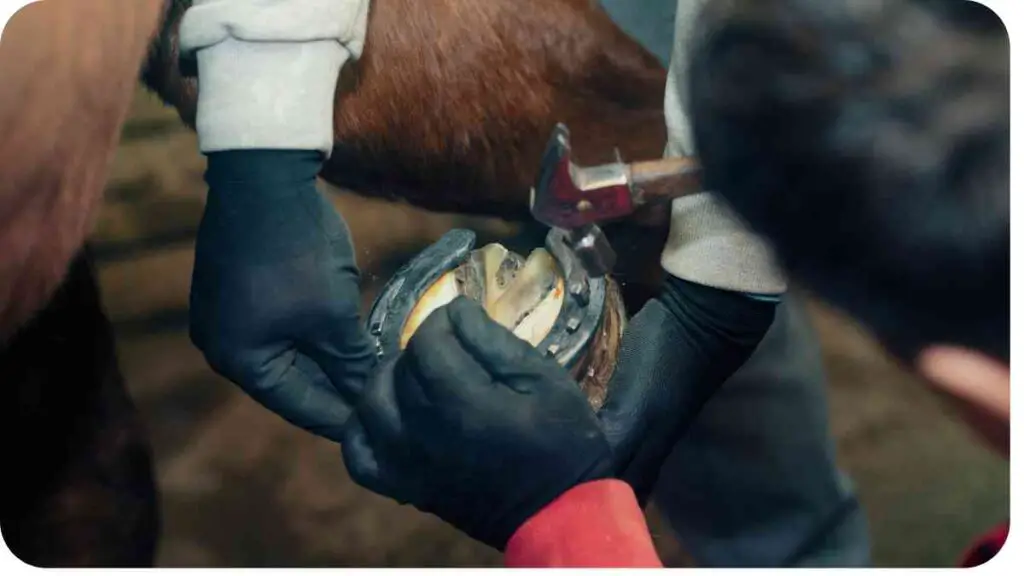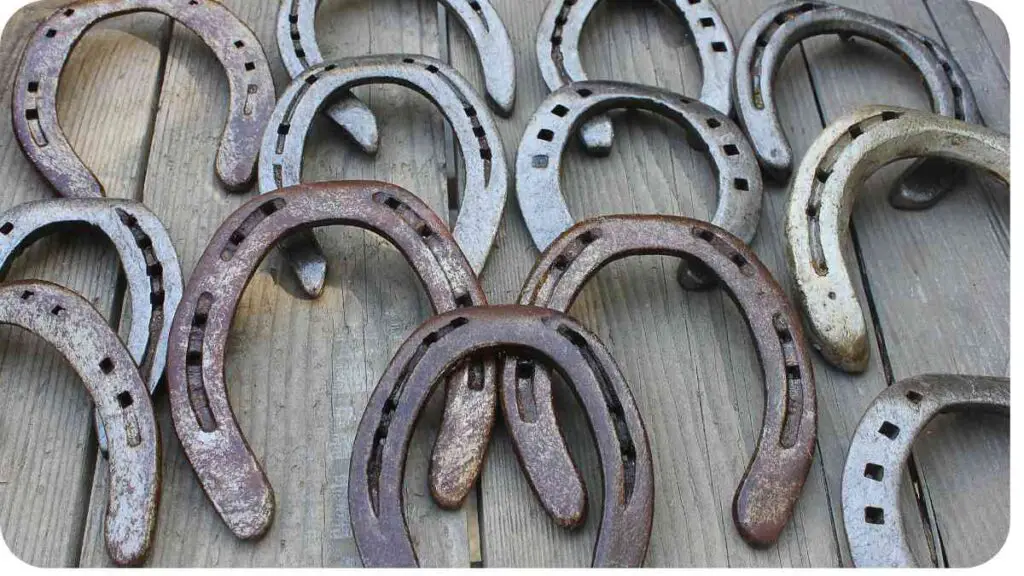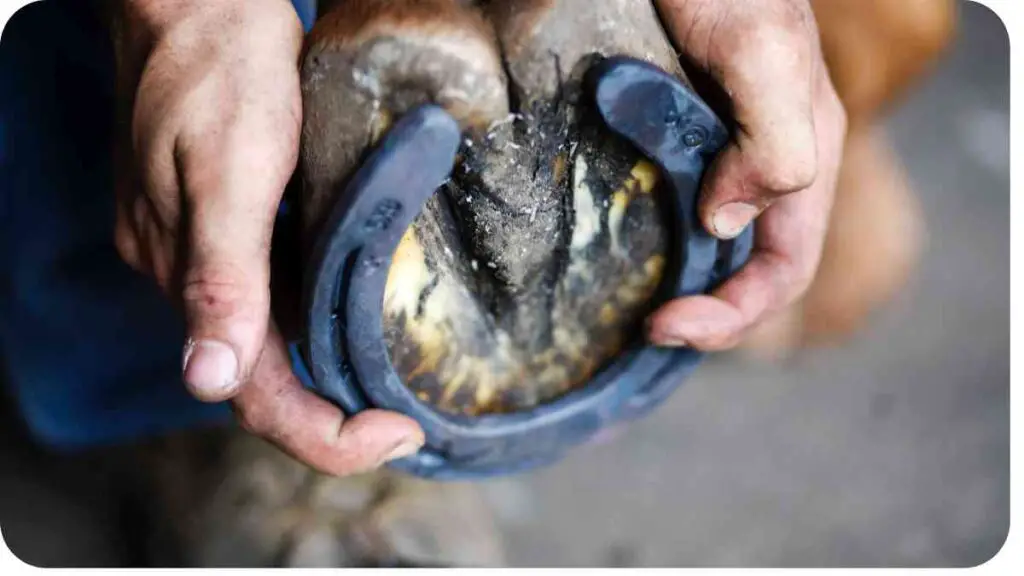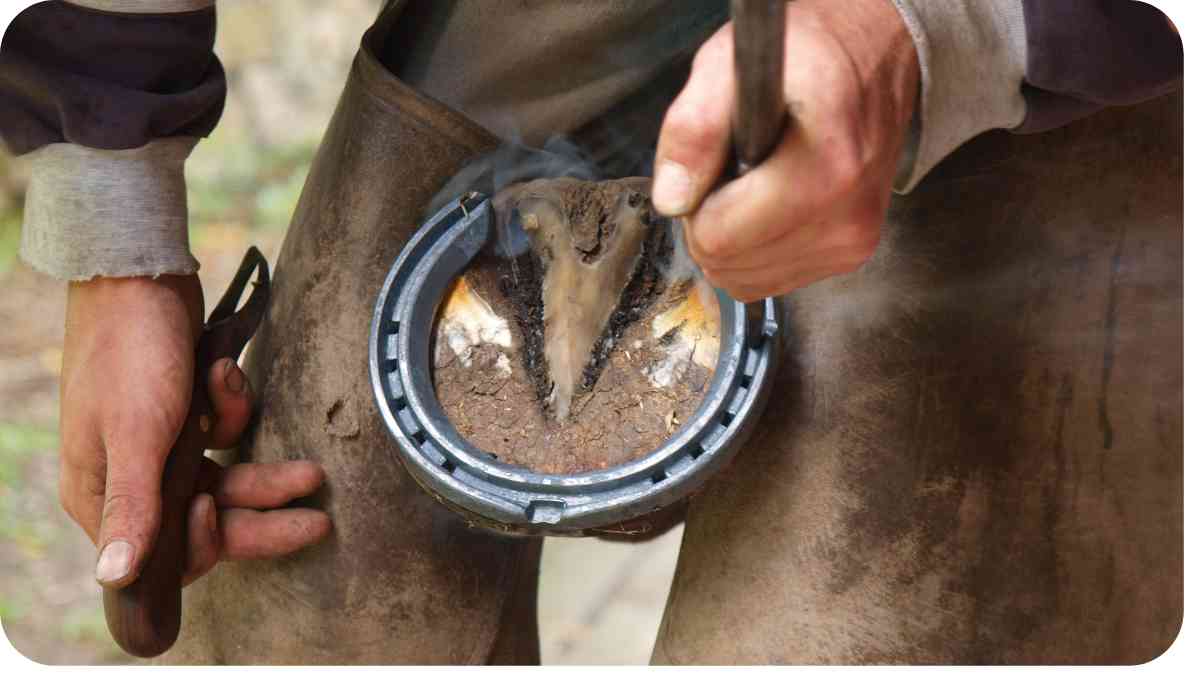As an equestrian enthusiast, you understand the significance of maintaining your horse’s well-being. One crucial aspect of equine care involves knowing when to add horseshoes.
In this comprehensive guide, we’ll explore the signs indicating your horse may need horseshoes, the different types available, how to properly size and fit them, and much more.
| Takeaways |
|---|
| 1. Proper horseshoeing is crucial: Understand the importance of maintaining your horse’s well-being through effective horseshoeing. |
| 2. Signs your horse needs horseshoes: Recognize indicators such as uneven hoof wear, tender hooves, and changes in gait. |
| 3. Different horseshoe types: Learn about traditional metal, synthetic, and specialty horseshoes and their pros and cons. |
| 4. Measuring and sizing: Know how to assess hoof shape, size, and angles for proper horseshoe selection. |
| 5. The horseshoeing process: Understand the steps, from preparing the hoof to fitting, nailing, and making necessary adjustments. |
| 6. Frequency of horseshoeing: Consider factors influencing frequency and recognize signs indicating it’s time for a new set. |
| 7. DIY vs. professional horseshoeing: Weigh the risks of DIY attempts and appreciate the benefits of professional farrier services. |
| 8. Cost considerations: Grasp the initial expenses and long-term cost benefits associated with proper horseshoeing. |
| 9. Common myths debunked: Dispel misconceptions about horseshoes, including comfort concerns and the necessity for all horses. |
| 10. Tips for maintaining healthy hooves: Learn practical tips for regular hoof cleaning, trimming, and proper nutrition. |
| 11. Case studies: Explore success stories illustrating the positive impact of proper horseshoeing on hoof rehabilitation and performance enhancement. |
| 12. Future trends: Stay informed about technological innovations and sustainable alternatives shaping the future of horseshoeing. |
2. The Importance of Proper Horseshoeing

Proper horseshoeing is more than just a tradition; it’s a fundamental aspect of equine health and performance. Horseshoes provide support, prevent uneven wear, and enhance overall hoof function. Understanding when and why to add horseshoes is essential for any horse owner or rider.
The Risks of Bare Hooves: “Discover the potential dangers of horses going barefoot, exploring the risks and challenges they face without the protection of horseshoes
3. Signs Your Horse Needs Horseshoes
3.1. Uneven Hoof Wear
One of the first signs that your horse may need horseshoes is uneven hoof wear. Observing the wear patterns can provide valuable insights into your horse’s gait and hoof health.
Table 1: Hoof Wear Patterns and Possible Issues
| Wear Pattern | Possible Issue |
|---|---|
| Excessive Heel Wear | May indicate a gait problem |
| Toe Wear | Could suggest imbalances |
| Uneven Side-to-Side | Might signal conformation issues |
3.2. Tender or Sensitive Hooves
Tender or sensitive hooves are another indication that your horse may benefit from horseshoes. Horseshoes provide a protective barrier, reducing the impact on sensitive hooves and minimizing discomfort.
Rubber Shoes: An Alternative: “Explore the advantages of using rubber shoes for horse hoof protection. Learn about this alternative and its impact on equine well-being and performance.
Table 2: Signs of Tender Hooves and Potential Solutions
| Signs of Tender Hooves | Potential Solutions |
|---|---|
| Flinching or Lameness | Consider adding horseshoes |
| Reluctance to Walk | May indicate sensitivity |
| Heat in Hooves | Seek professional evaluation |
3.3. Changes in Gait or Performance
Any noticeable changes in your horse’s gait or performance could be a red flag. If your horse is struggling or not performing as usual, it’s time to assess whether horseshoes could be the solution.
Table 3: Gait Changes and Possible Reasons
| Gait Change | Possible Reasons |
|---|---|
| Shortened Stride | Hoof discomfort or pain |
| Stumbling or Tripping | Lack of traction or imbalances |
| Reduced Stamina | Fatigue due to excessive strain |
4. Understanding Different Horseshoe Types

When it comes to horseshoes, one size doesn’t fit all. Understanding the various types available is crucial for making informed decisions about your horse’s hoof care.
Does Shoeing Hurt?: “Delve into the discussion on whether horseshoeing causes discomfort to horses. Understand the importance of ensuring horse hoof health and well-being through proper shoeing.
4.1. Traditional Metal Horseshoes
Traditional metal horseshoes, typically made of steel or aluminum, are the most common choice. They provide durability and are suitable for a wide range of activities, from leisurely rides to competitive sports.
Table 4: Pros and Cons of Traditional Metal Horseshoes
| Pros | Cons |
|---|---|
| Durable and long-lasting | May increase hoof heat buildup |
| Provides excellent traction | Adds weight to the hooves |
| Widely available | Requires regular maintenance |
4.2. Synthetic Horseshoes
Synthetic horseshoes, often made of materials like polyurethane or rubber, offer a lightweight alternative. They are popular for horses with specific hoof issues or those requiring therapeutic shoeing.
Table 5: Advantages and Disadvantages of Synthetic Horseshoes
| Advantages | Disadvantages |
|---|---|
| Lightweight and flexible | Limited durability |
| Absorbs shock well | May not provide enough traction |
| Ideal for therapeutic needs | Not suitable for heavy use |
4.3. Specialty Shoes for Specific Needs
Specialty horseshoes cater to specific requirements, such as traction enhancement, therapeutic support, or addressing particular gait irregularities.
Table 6: Examples of Specialty Horseshoes and Their Uses
| Specialty Horseshoe | Purpose |
|---|---|
| Traction Shoes | Enhanced grip on various surfaces |
| Therapeutic Shoes | Support for injured or ailing hooves |
| Corrective Shoes | Addressing specific gait issues |
5. How to Measure and Size Horseshoes
Ensuring the right fit is crucial for effective horseshoeing. Understanding how to measure and size horseshoes properly is a skill every horse owner should possess.
Donkeys’ Durable Hooves: “Explore the resilient hooves of donkeys and why they don’t require shoes. Learn about the natural durability of donkey hooves and how it differs from horses.
5.1. Assessing Hoof Shape and Size
Before selecting horseshoes, it’s essential to assess your horse’s hoof shape and size. This involves considering factors such as length, width, and the overall conformation of the hoof.
Table 7: Key Measurements for Hoof Sizing
| Measurement | How to Measure |
|---|---|
| Hoof Length | From the toe to the heel |
| Hoof Width | Across the widest part of the hoof |
| Heel-to-Heel Width | Distance between the heel bulbs |
5.2. Understanding Hoof Angles
Hoof angles play a crucial role in selecting the right horseshoe. Understanding the natural angles of your horse’s hooves helps in choosing a shoe that complements their conformation.
Table 8: Ideal Hoof Angles and Possible Adjustments
| Ideal Angle Range | Possible Adjustments |
|---|---|
| 50-55 degrees | Raise or lower the heel as needed |
| 45-50 degrees | Adjust breakover point for balance |
| Consistent side-to-side | Address conformational challenges |
6. The Horseshoeing Process

Now that you understand the importance of horseshoes and the types available, let’s delve into the horseshoeing process. Whether you’re a seasoned horse owner or a novice, grasping the basics can make a significant difference in your horse’s comfort and performance.
6.1. Preparation of Hoof
The horseshoeing process begins with preparing the hoof. This involves cleaning the hoof thoroughly, removing any debris or excess hoof material, and addressing any minor issues, such as flares or cracks.
Barefoot Beasts: What Horses: “Uncover the historical perspective on horses going barefoot. Dive into the practices and conditions horses faced before the use of protective horseshoes became common.
Table 9: Steps in Preparing the Hoof for Shoeing
| Step | Description |
|---|---|
| Cleaning the Hoof | Remove dirt, debris, and old hoof material |
| Trimming Excess Hoof | Create a balanced surface for shoe fitting |
| Addressing Minor Issues | Filling cracks or addressing flares |
6.2. Fitting and Nailing the Horseshoe
Once the hoof is prepared, the next step is fitting the horseshoe. This involves selecting the right size and type of shoe based on the horse’s hoof measurements and conformation. The shoe is then attached to the hoof using nails.
Table 10: Steps in Fitting and Nailing the Horseshoe
| Step | Description |
|---|---|
| Selecting the Right Shoe | Based on hoof measurements and conformation |
| Attaching the Shoe | Using nails to secure the shoe to the hoof |
| Ensuring Proper Fit | Checking for balance and alignment |
6.3. Adjustments for Comfort and Balance
After fitting the horseshoe, the farrier may make adjustments to ensure comfort and balance. This may involve modifying the shoe or applying additional materials to provide support and alleviate pressure points.
Table 11: Adjustments for Comfort and Balance
| Adjustment | Purpose |
|---|---|
| Shaping the Shoe | Ensuring proper fit and alignment |
| Adding Support Pads | Providing additional comfort and support |
| Checking for Balance | Ensuring weight distribution is even |
Understanding these steps empowers horse owners to engage in informed discussions with their farrier and actively participate in their horse’s hoof care.
7. Frequency of Horseshoeing
Knowing when to schedule horseshoeing sessions is crucial for maintaining your horse’s hoof health. Various factors influence the frequency, and understanding them helps in planning a proper hoof care routine.
7.1. Factors Influencing Frequency
Several factors impact how often your horse needs new horseshoes. These include the horse’s activity level, hoof growth rate, and the type of terrain they traverse.
Table 12: Factors Influencing Horseshoeing Frequency
| Factor | Influence |
|---|---|
| Activity Level | More active horses may need more frequent shoeing |
| Hoof Growth Rate | Faster-growing hooves may require more frequent care |
| Terrain Conditions | Harsh terrain may cause increased wear and necessitate more frequent shoeing |
7.2. Signs It’s Time for a New Set
Even with these factors in mind, it’s essential to recognize specific signs indicating it’s time for a new set of horseshoes. Regular inspections and awareness of your horse’s behavior can provide valuable insights.
Table 13: Signs It’s Time for New Horseshoes
| Sign | Indication |
|---|---|
| Excessive Wear | Rapid wear on the shoe or uneven patterns |
| Discomfort or Lameness | Changes in gait or reluctance to move |
| Loose or Damaged Shoes | Visible issues with the shoe or nails |
Understanding these signs enables proactive hoof care, ensuring your horse is always comfortable and ready for any adventure.
8. DIY vs. Professional Horseshoeing
As a horse owner, you might be tempted to try your hand at horseshoeing. While some basic hoof care tasks can be handled by owners, there are significant risks associated with DIY horseshoeing.
8.1. Risks of DIY Horseshoeing
Table 14: Risks of DIY Horseshoeing
| Risk | Consequence |
|---|---|
| Incorrect Shoeing | Can lead to imbalances and discomfort |
| Injury to the Horse | Inadequate skills may result in harm |
| Hoof Damage | Improper shoeing may damage the hoof |
8.2. Benefits of Professional Farrier Services
Turning to a professional farrier for horseshoeing offers numerous benefits. Farriers undergo extensive training and possess the expertise needed to ensure proper shoeing without compromising your horse’s well-being.
Table 15: Benefits of Professional Farrier Services
| Benefit | Value |
|---|---|
| Skill and Expertise | Trained professionals ensure proper shoeing |
| Customization | Tailored solutions based on individual needs |
| Early Issue Detection | Professionals can identify and address potential problems |
While DIY horseshoeing might seem cost-effective, the long-term health and performance of your horse are best entrusted to a skilled farrier.
9. Cost Considerations
Understanding the costs associated with horseshoeing is crucial for budget-conscious horse owners. While initial expenses may seem significant, the long-term benefits often outweigh the investment.
9.1. Initial Horseshoeing Expenses
Table 16: Initial Horseshoeing Expenses
| Expense | Details |
|---|---|
| Farrier Fees | Charges for professional services |
| Horseshoe Cost | Price of the horseshoes |
| Additional Materials | Pads, nails, and other necessary supplies |
9.2. Long-Term Cost Benefits
Investing in proper horseshoeing pays off over time. Well-maintained hooves contribute to your horse’s overall health, preventing more significant issues that could result in costly veterinary bills.
Table 17: Long-Term Cost Benefits
| Benefit | Value |
|---|---|
| Reduced Vet Bills | Prevention of hoof-related issues |
| Extended Shoe Lifespan | Proper care ensures longer-lasting shoes |
| Enhanced Performance | Healthy hooves contribute to better performance |
Understanding both the initial expenses and long-term benefits allows horse owners to make informed decisions that prioritize their horse’s well-being.
10. Common Horseshoeing Myths Debunked
In the world of horseshoeing, myths and misconceptions abound. Let’s debunk some of the most common ones to ensure you have accurate information for your horse’s care.
10.1. “Horseshoes Are Uncomfortable for Horses”
Table 18: Dispelling the Myth – Horseshoes and Comfort
| Myth | Reality |
|---|---|
| Horseshoes Hurt Hooves | Properly fitted horseshoes enhance comfort |
| Hooves Need to Breathe | Horses don’t have sweat glands in their hooves, allowing for shoeing |
10. Common Horseshoeing Myths Debunked
10.2. “All Horses Need Shoes”
Table 19: Dispelling the Myth – Not All Horses Require Shoes
| Myth | Reality |
|---|---|
| Every Horse Needs Horseshoes | Properly maintained hooves may not require shoeing |
| Barefoot Horses are Unhealthy | Some horses can thrive without shoes if managed properly |
Understanding these myths helps horse owners make informed decisions based on their individual horse’s needs rather than succumbing to common misconceptions.
11. Tips for Maintaining Healthy Hooves
Proactive hoof care is essential for maintaining your horse’s overall health and well-being. Here are some practical tips to ensure your horse’s hooves stay in top condition.
11.1. Regular Hoof Cleaning and Trimming
Table 20: Hoof Maintenance Tips
| Tip | Description |
|---|---|
| Clean Hooves Regularly | Remove debris and check for any abnormalities |
| Schedule Regular Trims | Prevent overgrowth and maintain proper angles |
| Monitor for Changes | Keep an eye on your horse’s hooves for any signs of issues |
11.2. Proper Nutrition for Hoof Health
Table 21: Nutritional Tips for Hoof Health
| Tip | Importance |
|---|---|
| Provide a Balanced Diet | Essential nutrients support hoof growth |
| Supplement with Biotin | Biotin promotes healthy hoof development |
| Consult with a Nutritionist | Tailor the diet to your horse’s individual needs |
By incorporating these tips into your routine, you can contribute to the overall well-being of your horse.
12. Case Studies: Success Stories in Horseshoeing
Real-world examples illustrate the positive impact of proper horseshoeing. Let’s explore two case studies showcasing successful outcomes.
12.1. Rehabilitation of Hoof Issues
Table 22: Case Study – Hoof Rehabilitation
| Challenge | Solution |
|---|---|
| Severe Cracks and Flares | Professional farrier intervention |
| Regular Maintenance Plan | Scheduled trims and corrective shoeing |
| Gradual Improvement | Over time, hooves regained health and integrity |
Understanding the journey of horses facing hoof challenges highlights the potential for recovery through consistent and professional care.
12.2. Performance Enhancement Through Proper Shoeing
Table 23: Case Study – Performance Enhancement
| Challenge | Solution |
|---|---|
| Gait Irregularities | Thorough assessment by an experienced farrier |
| Customized Therapeutic Shoes | Tailored to address specific gait issues |
| Improved Performance | Enhanced gait, stamina, and overall performance |
These success stories emphasize how proper horseshoeing can lead to remarkable improvements in a horse’s life.
13. Future Trends in Horseshoeing
The world of horseshoeing is evolving, with emerging trends that promise innovation and sustainability.
13.1. Technological Innovations
Table 24: Future Trends – Technological Advancements
| Trend | Impact |
|---|---|
| Smart Hoof Monitoring | Real-time data for early issue detection |
| 3D Printing for Custom Shoes | Personalized solutions for individual needs |
13.2. Sustainable and Eco-Friendly Alternatives
Table 25: Future Trends – Sustainability in Horseshoeing
| Trend | Contribution |
|---|---|
| Recyclable Materials | Environmentally friendly horseshoe options |
| Eco-conscious Practices | Farriers adopting sustainable approaches |
As technology advances and environmental awareness grows, the future of horseshoeing holds exciting possibilities.
14. Conclusion
In conclusion, knowing when to add horseshoes to your horse is a critical aspect of responsible horse care. This comprehensive guide has covered the signs that indicate your horse may need horseshoes, the types available, the fitting process, and considerations for maintaining healthy hooves.
We’ve debunked common myths, provided case studies showcasing the positive impact of proper horseshoeing, and looked ahead to future trends in the industry.
By understanding the nuances of horseshoeing, you empower yourself as a horse owner to make informed decisions that prioritize your horse’s well-being.
Whether you choose traditional metal horseshoes, synthetic alternatives, or specialty shoes tailored to specific needs, the key is regular assessment and timely intervention.
Remember, horseshoeing is not just a practical necessity; it’s a commitment to your horse’s comfort, health, and performance.
So, the next time you hear the familiar clip-clop of hooves, you can rest assured that your horse is not just well-shod but also well-cared-for.
Further Reading
- Why Do Horses Need Shoes? A Comprehensive Horse Shoeing Guide
- Explore this guide to understand the reasons behind why horses need shoes and gain insights into the horse shoeing process.
- Horseshoes: What Exactly Are Their Purpose?
- Delve into the specific purposes of horseshoes and gain a deeper understanding of their role in maintaining equine health.
- The Art and Science of Horseshoeing
- This resource delves into the art and science of horseshoeing, providing a comprehensive perspective on the various aspects of this essential equine practice.
FAQs
How often should I check my horse’s hooves for signs of needing horseshoes?
Regularly inspect your horse’s hooves. If you notice uneven wear, tenderness, or changes in gait, it’s time to consider horseshoeing.
Are all horses suitable candidates for synthetic horseshoes?
Not necessarily. While synthetic horseshoes have benefits, their suitability depends on individual hoof conditions and the horse’s activities.
Can I save money by attempting DIY horseshoeing?
Attempting DIY horseshoeing poses risks of incorrect shoeing, potential injury, and hoof damage. It’s advisable to rely on professional farrier services.
What factors influence the frequency of horseshoeing?
Activity level, hoof growth rate, and the terrain horses traverse all contribute to the frequency of horseshoeing.
Do horseshoes hurt horses? Are there alternatives for horses that may find them uncomfortable?
Properly fitted horseshoes enhance comfort, but alternatives like hoof boots or barefoot options may be suitable for certain horses.

Hi there! My name is Hellen James, and I’m a horse riding expert. I’ve been riding horses since I was just a kid—and it’s been my passion ever since. But getting started with horse riding can be overwhelming. There’s so much to learn! If you’re looking for a way to get started and make sure you’re doing it right, I’m here to help.


